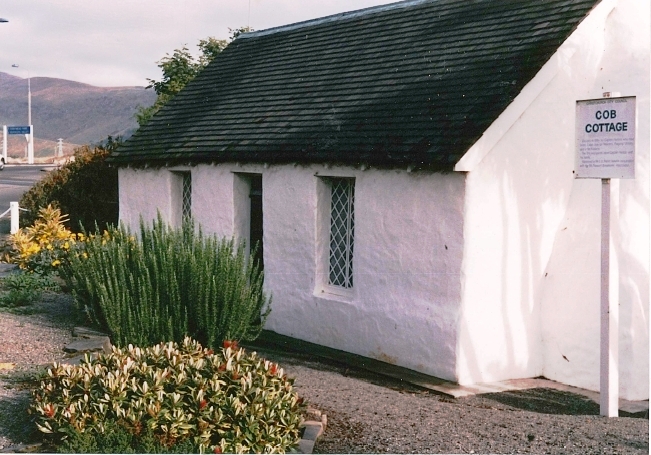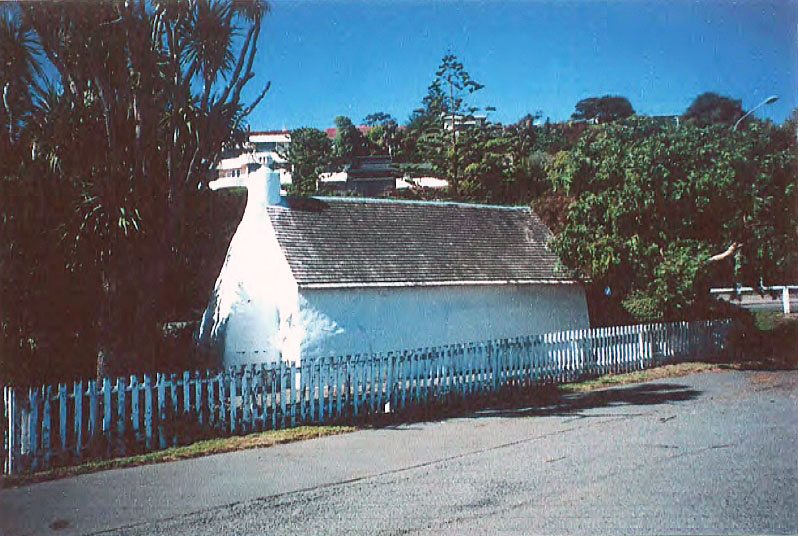There is little solid evidence concerning the building or habitation of the Ferrymead Cob Cottage. What is reasonably certain is that the house was built by James Penfold (1833-1905), possibly assisted by a neighbour Mr. Roberts, during the early 1860s, and inhabited by the Penfold family for between 7 and 14 years until about 1878 at the latest. [Updated information: Deed of 17 September 1870 mentions a lease for James Penfold to contract 'to build and complete a sod house with at least two rooms'] Penfold may have first arrived in Canterbury as early as 1851; an agricultural labourer of this name was on board the Travancore when it sailed in to Lyttelton that year. Whatever his origins, by the end of the decade Penfold was apparently in command of a small vessel trading between Australia and New Zealand. He was married in Christchurch in 1863. When railways were established in Canterbury in the 1860s, Penfold became an employee. He was involved in bringing the first sleepers from Pigeon Bay for the seminal Ferrymead-Christchurch line (1863), and worked on the construction of the nearby Lyttelton tunnel (1860-67). Penfold remained with the railways for thirty years, moving to the Southbridge district about 1877 following the opening of the Southbridge branch line. The Ferrymead cottage would logically date from early in Penfold's time at Ferrymead. Certainly Penfold was in possession of a section in the nearby Ferrymead township in 1865. As constructed, the building had casement windows and was reputedly initially thatched with rushes. By the turn of the century two rooms had been created by the insertion of a wooden partition, sleeping space was provided in a loft, an addition (probably weatherboard) had been made to the rear, and the roof of the main part had been shingled. During the thirty years following the end of the Penfolds' occupation, the house was (reputed) to have been occupied in succession by five families of new immigrants. In the early years of the twentieth century (about 1908) it was abandoned, and by the end of the 1920s was a roofless ruin. In 1940-44 the cottage was almost completely reconstructed (in simplified form) by former dairy farmer Mr E. S. Parish with assistance from members of the Mt. Pleasant Burgesses' Association and the Mt. Pleasant Boating Club (who leased the site). The loft, lean-to, and partition wall were not rebuilt. The cottage was thatched, and lattice-glazed windows (that had been removed from J. R. Godley's former house in Lyttelton around 1900) were installed. A grand re-opening attended by 7, 000 took place on Anniversary Day (16 December) 1944. Scott Brothers Ltd., the then owner of the building, gave it and 8903 square metres of land to the Christchurch City Council in 1946. This is now known as Scott Park. In 1948 the cottage was badly damaged by fire, but was again reconstructed by Parish. It was shingled in 1963/4. Parish continued to care for the building, opening it to the public on a regular basis, until his death in 1969. After Parish's death the cottage was neglected, and required significant repair in 1983. This included rebuilding sections of wall, the application of a cement plaster, and the installation of a new door. By 1996 major deterioration was evident. A conservation plan was prepared, and the Christchurch City Council carried out renovations in 1997-98. These included repair of the walls with cob blocks, strengthening, replacement of the windows with more accurate replicas, the stripping of cement plaster, limewashing, and the installation of a ventilation system to air the interior. A number of circumstances have led to the accumulation of a good deal of myth and misinformation around the Penfold cottage. One reason was that the tenure of the Penfold family was comparatively short, and the family moved from the district. Another was that the building was abandoned almost forty years before its reconstruction. The most significant factor however, may be the complex legal history of the land on which the cottage sits. In 1856, the Crown granted a Ferrymead property to Edward Hooper Kittoe of Chadwell, Essex. The legal description of this block included a parcel north of the Sumner Road (on which the Penfold cottage was subsequently built), but the survey plan did not. The assumption seems to have been, however, that Kittoe's land included this parcel. Edward Kittoe may have been an absentee landowner, which could account for Penfold's decision to build his house on the land. Penfold did not own the land, and does not appear to have had any formal agreement. Kittoe eventually sold his property to New Zealand residents Richard Parker, Alfred Flavell, and Alfred Smith (who held a third share each) in 1878. The sale serves to confirm the probably nebulous nature of Penfold's tenure, for it was reputedly at this time the family departed for Southbridge. The Ferrymead property subsequently passed through several hands until 1898, when an application was made to rectify the anomaly between the legal description and the survey plan. A first title was issued at this time showing the corrected boundary, and recording the sale by James Johnston (of Wellington) and William Langdown of Langdown's share to contractor and quarryman Samuel Paul Andrews. Andrews had leased the property since 1892, and appears to have actually purchased Langdown's share in 1895. In the 1940s restorer Parish set down misnomer and conjecture as fact, and this was embroidered through the years. By the time a sign (replaced in 1998) was erected outside the cottage, the construction date had moved to 1884 - well after the family had left the area. Other construction dates bandied about in the last 60 years include 1861, 1862, 1864, and 1873. The 'Mr Penfold' of his Lyttelton Times obituary in 1905 was also raised to the position of 'Captain', and said to have been a cabin boy on Nelson's Victory - though the Victory last sailed more than 20 years before Penfold's birth. Another significant part of the legend is that 'Captain' Penfold commanded a boat called the Excelsior, which was wrecked on the Sumner Bar. This, so the story goes, was the event that caused Penfold to settle at Ferrymead, and pieces of the wreck were subsequently incorporated into his new cottage. Although a number of vessels came to grief on the Sumner bar in the 1860s, local historian Colin Amodeo has found that none were named Excelsior. Indeed the only possible candidate, an Australian built vessel of this name, traded up the Heathcote from 1871 until it was wrecked on the Kaikoura Coast in 1878 - some 15 years after Penfold's sea-going career had ended. The cottage's future is currently uncertain (April, 2004.) The Christchurch City Council is proposing to replace the nearby bridge over the Heathcote River. This would be accompanied by some realignment of the roads - which is likely to impact on the cottage site. City engineers have indicated that shifting the house might be an option.



Location
List Entry Information
Overview
Detailed List Entry
Status
Listed
List Entry Status
Historic Place Category 2
Access
Private/No Public Access
List Number
3101
Date Entered
6th June 2004
Date of Effect
6th June 2004
City/District Council
Christchurch City
Region
Canterbury Region
Extent of List Entry
Registration includes the house, its fittings and fixtures, and the land on RT CB369/12.
Legal description
Pt RS 4 Blk XVI (RT CB369/2), Canterbury Land District
Location Description
Registration includes the house, its fittings and fixtures, and the land on CT CB369/12.
Stay up to date with Heritage this month
